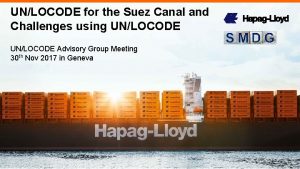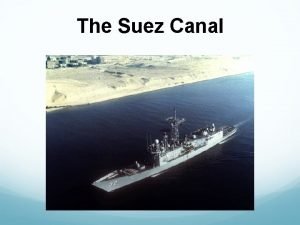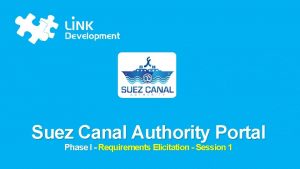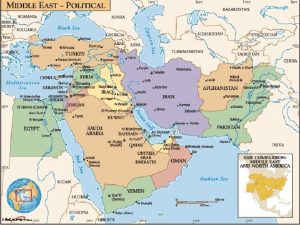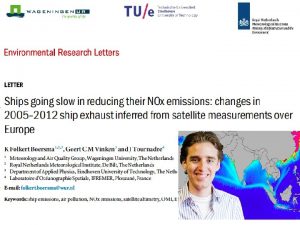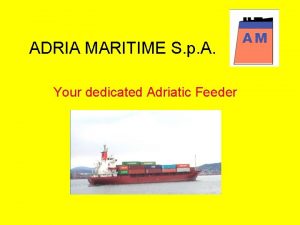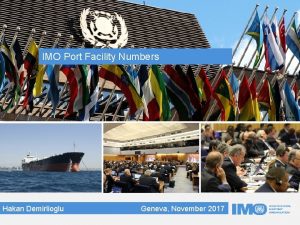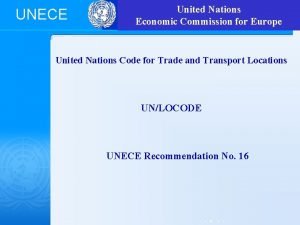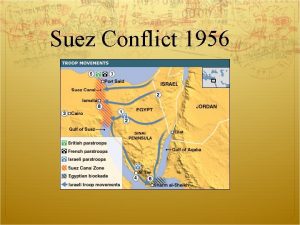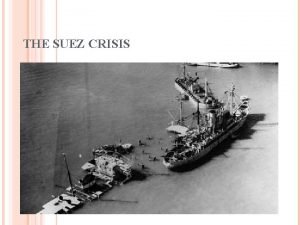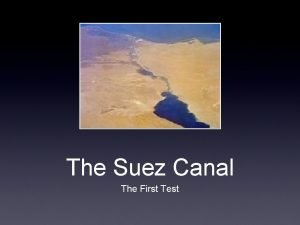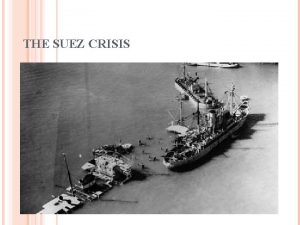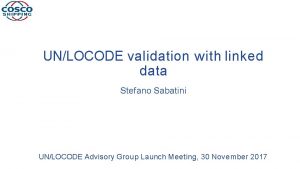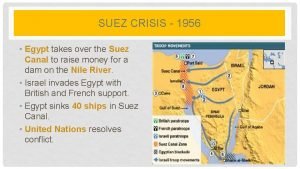UNLOCODE for the Suez Canal and Challenges using











- Slides: 11

UN/LOCODE for the Suez Canal and Challenges using UN/LOCODE Advisory Group Meeting 30 th Nov 2017 in Geneva

UN/LOCODE for the Suez Canal Role of the Suez Canal One of the most important and most heavily used waterways in the world. 17500 vessels passing per year (48 per day) including the largest container ships of 20. 000+ TEU capacity All shipping lines operating between the Far East / India subcontinent and Europe, North Africa and the US East Coast have to include the Suez Canal passage in their vessel schedules. Source www. maerskline. com 2 UN/LOCODE Advisory Group Meeting 30 th Nov 2017 by Michael Schröder, Hapag-Lloyd

UN/LOCODE for the Suez Canal Missing a standard denomination for the Suez Canal Northern entrance: City of Port Said UN/Locode = EGPSD Length 190 KM Southern entrance: City of Suez UN/Locode = EGSUZ 3 UN/LOCODE Advisory Group Meeting 30 th Nov 2017 by Michael Schröder, Hapag-Lloyd The Suez Canal is a milestone in the vessel schedule on the voyage between Far East and Europe. Timely arrival is essential. Due to the lack of a UN/Locode, the codes EGPSD or EGSUZ are used to determine the Suez Canal passage. But the same codes EGPSD and EGSUZ are also used to determine a call at these ports. Currently it is not possible to distinguish between calling these ports and just passing by on the way to the Canal entrance.

UN/LOCODE for the Suez Canal Distinguish between calling and passing a port Example schedule for vessel CMA CGM MAUPASSANT EGSUZ is often used to indicate the canal passage, but it is not standard and it can be mistaken with for a port call at Suez. calling calling passing calling calling 4 UN/LOCODE Advisory Group Meeting 30 th Nov 2017 by Michael Schröder, Hapag-Lloyd

UN/LOCODE for the Suez Canal Panama Canal and Kiel Canal The reasons outlined above apply likewise to all 3 canals. Of note: The UN/Locodes for Panama Canal and for Kiel Canal have been published on the UN website for some years already. Current UN/LOCODE repository: Kiel Canal DECKL Published with status ‘RL’ Recognized Location since 2011. Function ‘ 6’ multimodal. Panama Canal PAPCN Published with status ‘RQ’ Request under Consideration since 2012. Function ‘ 3’ Road Terminal. Suez Canal EGSCN New request Conclusion Each canal Locode should get a status of Approved or Recognized, and a function code ‘ 6’ multimodal (or a new function code) to distinguish them from a ‘regular’ location. 5 UN/LOCODE Advisory Group Meeting 30 th Nov 2017 by Michael Schröder, Hapag-Lloyd

Challenges and difficulties using UN/LOCODE Container Terminals should not receive their own UN/Locode as if they were ports Example Istanbul from UN/Locode repository Istanbul TRIST Marport terminal TRMPT Mardas terminal TRMAD Akcansa terminal TRAKC Kumport terminal TRKMX Haydarpasa terminal TRHAY Metropolitan Area Single container terminals in Istanbul …there are more… 6 UN/LOCODE Advisory Group Meeting 30 th Nov 2017 by Michael Schröder, Hapag-Lloyd Issue: Currently many container terminals get their own UN/Locode assigned. Same time, the Metropolitan Area in which they are located carries its own, mostly well known UN/Locode (e. g. TRIST). Both the terminal and the Metropolitan Locode are valid and published. This ambiguity has counter-productive effects to all standardization efforts!

Challenges and difficulties using UN/LOCODE Illustration: Istanbul Container Terminals in Ambarli port complex Marport Main TRMPT Marport West TRMPT 7 Akcansa TRAKC Kumport TRKMX Mardas TRMAD Terminals with own UN/LOCODE Advisory Group Meeting 30 th Nov 2017 by Michael Schröder, Hapag-Lloyd Issue: Currently each terminal has its own UN/Locode. The terminal location is a subset of the bigger metropolitan location. But this relation is not visible in the UN/Locode directory.

Challenges and difficulties using UN/LOCODE Container Terminals should not receive their own UN/Locode as if they were ports Other examples, same issues PLGDY Metropolitan Area Gdynia PLGCT Container terminal in Gdynia KRPUS Metropolitan Area Busan KRBNP Container terminal “Busan New Port” CNTNJ Metropolitan Area Tianjin CNTNG Tianjin Port CNTXG Tianjin Xingang Port CNTBS Tianjinbaoshuiqu Terminal …there are many more… 8 UN/LOCODE Advisory Group Meeting 30 th Nov 2017 by Michael Schröder, Hapag-Lloyd The hidden hierarchy Metropolitan Area Terminal

Challenges and difficulties using UN/LOCODE Container Terminals should not receive their own UN/Locode as if they were ports The better solution for terminals: Use the UN/LOCODE for the Metropolitan Area. Use the SMDG Terminal Code (child coding list) for the container terminal Examples in the LOC segment – should be: LOC+UNLOCODE+SMDG Terminalcode’ LOC+PLGDY+PLGCT’ LOC+KRPUS+PNP’ LOC+CNTNJ+THCC 1’ While this is the valid UN/Edifact standard, it is acknowledged that some trading partners have not yet upgraded their IT system to this standard. 9 UN/LOCODE Advisory Group Meeting 30 th Nov 2017 by Michael Schröder, Hapag-Lloyd Conclusion Make the relation between the Metropolitan Area and the Subset Location visible in the UN/Locode directory. Make reference to a child coding list where applicable.

Challenges and difficulties using UN/LOCODE Change management: Old Codes should never be re-used for another location Example from Brazil, changes in 2017: Location Old Locode New Locode Old Locodes should never be re-used for another location. Vacaria BRVCA BRVAC Vitoria da Conquista BRVDC BRVCA Re-use is counter-productive for standardized data exchange Vila Do Conde BRVLC BRVDC = re-use which should be avoided. 10 UN/LOCODE Advisory Group Meeting 30 th Nov 2017 by Michael Schröder, Hapag-Lloyd UN/Locodes are kept in historic data storage (for example in data warehouse) for 10+ years.

Challenges and difficulties using UN/LOCODE Validation management: Some Locodes are pending over years Example from previous slides: Location Locode Validation status Panama Canal PAPCN Status “RQ” (Request under consideration) since 2012 -07 Marport TRMPT Status “RQ” (Request under consideration) since 2006 -07 Busan New Port KRBNP Status “RQ” and remark “Under scrutiny” since 2014 -01 Conclusion When a Locode gets published, the maritime community should be given a degree of confidence that this Locode can be used. It is impractical to keep a Locode in a pending status over many years. 11 UN/LOCODE Advisory Group Meeting 30 th Nov 2017 by Michael Schröder, Hapag-Lloyd
